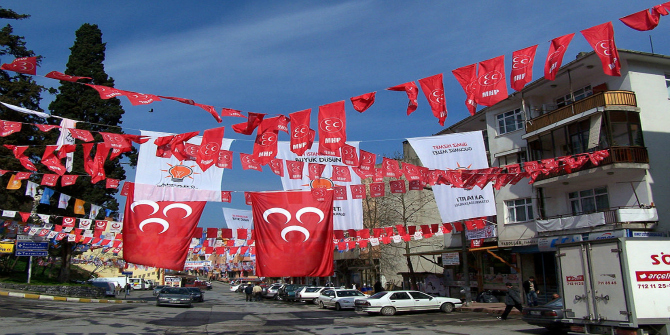In A Short History of the Russian Revolution, Geoffrey Swain challenges the historical narrative that the Bolsheviks co-opted an otherwise reform-minded labour movement for revolutionary purposes, instead underscoring the radicalism of Russian workers. On 7 November 2017, the centenary of the October Revolution of 1917, Barton Edgerton reviews this work, finding that, more than anything, it suggests the contingency of the multiple events behind this world-changing Revolution.
If you are interested in this review, you may also like to read Geoffrey Swain’s own reflections on the book, published on the LSE RB blog in March 2017.
A Short History of the Russian Revolution. Geoffery Swain. IB Tauris. 2016.
Evidently there is good reason why matryoshka – Russian nesting dolls – are used as a metaphor for the complexities of then Soviet, now Russian, politics. The Russian Revolution, from its antecedents in 1905 to the February and October revolutions of 1917, is a story of rising and falling alliances among a large set of interwoven individuals and groups. Geoffrey Swain’s A Short History of the Russian Revolution aims to provide a cogent history of these events.
Swain argues that, since at least the 1960s, the orthodox view of the Russian Revolution has held that the Bolsheviks took advantage of the instability created by the First World War and the failure of the February Revolution to take power from its minority position in a coalition government. In this narrative, Lenin’s party co-opted reform-minded labour movements for revolutionary purposes. A Short History aims to counter what Swain believes to be a flawed story by highlighting the revolutionary rather than reform-oriented tradition of Russian labour. For the author, this alternative to the orthodoxy is clear in the 1905 Revolution and the period between that and 1917. Rather, Swain believes, it is the 1917 reformist-oriented February Revolution that is the anomaly to an otherwise revolutionary movement.
Constructing this argument is a daunting task given the interplay between various social and political groups and individuals across the time period. A Short History runs just over 200 pages, and the inevitable constraints of space and genre do not permit the author room to fully set the scene, describe the stage or introduce the characters. The result is a history but not an introduction, which assumes a fair bit of background knowledge. A knowledgeable reader will likely be interested in Swain’s counter to the orthodox interpretation of Russian labour. However, comfortably familiar names to nearly all readers, such as Lenin and Joseph Stalin, do not enter the story for nearly 50 pages. Those with little previous knowledge of the period have little to anchor themselves and may need to approach the work with support materials. For these novices, the read might seem like attending a dinner party where you know only the host, but all of the guests seem to know each other: one can join the conversation but only as an outsider. One can learn the names of those at dinner but must make an effort to remember who is who, what their backstory is and how they relate to one another.
 Image Credit (Mark Morgan CC BY 2.0)
Image Credit (Mark Morgan CC BY 2.0)
Swain nevertheless makes his argument over eight short chapters which proceed chronologically across a twelve-year period from 1905 to the end of 1917. The introduction places the book amidst a range of Soviet historical scholarship. Here, Swain articulates his core argument that the Russian Revolution was a popular one, led by the revolutionary tradition of Russian labour. Furthermore, that the February Revolution was a reformist anomaly and that the October Revolution righted the revolutionary ship. Both the introduction and the first chapter also aim to historically situate the coalition government that arose following the abdication of Tzar Nicholas II in March 1917.
The third and fourth chapters give an overview of first the successes, and then the failures, of the coalition government to lay the groundwork for a stable political environment. As written, it seems a bit strange to highlight the success of the coalition government. While there are certainly elements worth highlighting, the success itself was relatively short-lived. It was just five months from the Tzar’s abdication to liberal ministers leaving the provisional government on 2 July. Only two months later, Lavr Kornilov’s failed coup created a chaotic period of governance that eventually led to a Bolshevik-centred government at the end of 1917.
Chapter Five breaks with the chronological progression. Swain takes a step back to look at the social unrest present in Russia between February and September 1917. Much of the focus is on land and industrial policy, which is used to support the author’s larger argument about the revolutionary tradition of Russian labor. He describes the creation of factory and land committees, and how deteriorating economic productivity for both urban and rural labourers made it difficult for workers of all types to remain in support of anything short of revolution. Further, many were induced to violence as part of their protest of the existing order, represented in the previous six months by a provisional government and two failed coalitions. The chapter ends with soldiers being asked to quell the unrest, many of whom, the author argues, were likely skeptical of the order they were being used to support.
The final three chapters build a story that ends with a Bolshevik-dominated government at the end of 1917. Kornilov’s failed coup opened an opportunity for Lenin’s Bolsheviks to exploit. They did so by sowing the seeds of insurrection and unrest. Chapter Six describes Swain’s perspective on this. The final two chapters, Seven and Eight, detail the political wrangling that led to the Bolshevik-dominated Soviet Government that set the stage for the five-year civil war that would begin soon after.
Perhaps the most striking feature of these last chapters is how tenuous the final outcome seems to be. It is unclear if Swain intends for the reader to take this away from the text or not. At the end of A Short History, one is left wondering if a less repressive regime could have arisen out of the Tzar’s abdication. In retrospect, much of what happens seems inevitable, but Swain’s narrative suggest a great deal of contingency. One might consider what would have happened if only the Tzar had been willing to make more concessions prior to 1917. If a slightly less repressive industrial and agricultural policy had been developed. If the moderates had made a few more concessions in the earlier governments. If Lenin had made a different choice at one of the many pivotal decision points in 1917.
The current political environment makes it clear that compromise is often difficult for leaders within parties, not to mention between them. Without Lenin healing those cleavages, it is difficult to imagine a Bolshevik-dominated Soviet Government. And without a Bolshevik-dominated Soviet, it is difficult to imagine an easy path for Stalin to come power. As each layer is pulled back, each new matryoshka exposed, the story seems to get only more complex and the reader is left to wonder if, but for a small change here or there, history could have been otherwise.
Barton Edgerton finished at the LSE in 2009 with a PhD in government. In an academic capacity, he has served as a visiting fellow in the government department at Harvard and as an adjunct in the political science department at Tufts. His research interests focus on the intersection of political theory, international relations and jurisprudence. For the past several years, he has worked in management consulting as an associate director and research consultant working with heads of HR, audit and risk management to help large, global organisations manage their largest strategic risks. Read more by Barton Edgerton.
Note: This review gives the views of the author, and not the position of the LSE Review of Books blog, or of the London School of Economics.


 Find this book:
Find this book: 





1 Comments